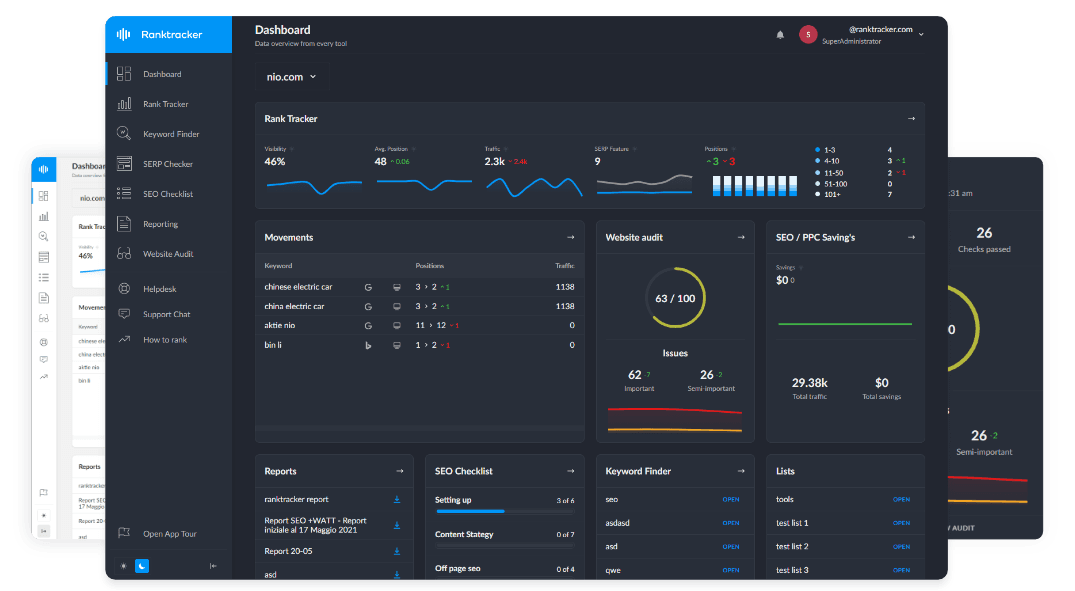Intro
Data is everywhere, but making sense of it can feel like searching for a needle in a haystack. Many business owners struggle to understand how to make use of the piles of information they collect every day.
Without clear insights, decision-making becomes guesswork, and opportunities slip through the cracks.
Did you know that businesses relying on data analytics tools are 5 times more likely to make faster decisions? Using these tools isn’t just about handling numbers. It’s about turning raw data into valuable guidance that drives revenue and reduces costs.
This blog will guide you on how to make data work for you. From understanding customer habits to spotting market trends, we’ll break down key strategies step by step. Ready to discover what your business could accomplish with smarter choices? Let’s begin!
Key Takeaways
- Businesses using data analytics tools are 5 times more likely to make quicker, fact-based decisions, enhancing efficiency and minimizing missed opportunities.
- Gathering relevant data tied to KPIs and merging internal records with external sources improves accuracy and conserves time for analysis.
- Predictive analytics helps forecast trends, improve inventory management, allocate resources effectively, and refine marketing strategies tailored to customer behavior.
- Real-time dashboards monitor operations like logistics or resource allocation, allowing immediate enhancements in efficiency and cost reduction.
- Future tools will rely on AI and machine learning for advanced forecasting while focusing on security with encryption protocols for safer decision-making.
Identifying and Collecting Relevant Data
Understanding what to gather lays the foundation for effective data-based decision-making. Focus on collecting information related to your key performance indicators (KPIs). For example, a retail business might track customer purchase patterns or seasonal trends.
Tools like customer relationship management (CRM) software assist in consolidating and organizing this data quickly. For more tailored support on setting up scalable analytics systems, you can get in touch with Vigilant—a provider with experience in managed data and IT support services.
Organize internal records and pair them with external sources like market reports or industry comparisons. Use predictive analytics tools to identify gaps or opportunities in collected datasets.
The All-in-One Platform for Effective SEO
Behind every successful business is a strong SEO campaign. But with countless optimization tools and techniques out there to choose from, it can be hard to know where to start. Well, fear no more, cause I've got just the thing to help. Presenting the Ranktracker all-in-one platform for effective SEO
We have finally opened registration to Ranktracker absolutely free!
Create a free accountOr Sign in using your credentials
As Peter Drucker once said, “What gets measured gets managed.” Starting with relevant details saves time while ensuring accurate analysis later.
Leveraging Data Analytics for Decision Making
Data analytics lets businesses make smarter choices based on facts, not guesses. It paints a clear picture of what drives success and what slows progress.
Analyzing customer behavior
Understanding customer behavior can provide valuable insights for your business. Tracking purchase patterns, website visits, and product preferences reveals what customers want. This helps you create offers that resonate with their needs while enhancing satisfaction.
Tools like Customer Analytics assist in identifying trends among different groups, helping businesses predict future actions more effectively.
Segmenting customers based on spending habits or interactions makes targeting easier. For example, loyal buyers may respond well to exclusive promotions. Meanwhile, new shoppers might need introductory discounts to stick around longer.
Analyzing feedback also identifies pain points in the buyer journey that impact retention rates. These adjustments often lead to better experiences and higher revenue growth over time.
Forecasting market trends
Predictive analytics helps businesses maintain a leading position. By examining historical data, companies can identify patterns and forecast future outcomes. Firms that foresee changes in market demand gain an advantage.
For instance, analyzing seasonal sales trends allows retailers to stock desired items at the right time.
Staying informed about consumer preferences enhances decision-making. Machine learning models detect subtle changes in buying behavior before they become evident to competitors. Focus on these insights to adapt strategies to new opportunities.
The All-in-One Platform for Effective SEO
Behind every successful business is a strong SEO campaign. But with countless optimization tools and techniques out there to choose from, it can be hard to know where to start. Well, fear no more, cause I've got just the thing to help. Presenting the Ranktracker all-in-one platform for effective SEO
We have finally opened registration to Ranktracker absolutely free!
Create a free accountOr Sign in using your credentials
Simplifying processes becomes more feasible when trends are predictable.
Optimizing Business Operations with Data Analytics
Data analytics identifies unnoticed inefficiencies in daily operations. It assists businesses in making better decisions to maintain a competitive edge.
Streamlining processes
Smooth operations keep businesses thriving. Data analytics tools can refine workflows and reduce inefficiencies with clear insights.
- Analyze performance metrics to identify bottlenecks in workflow systems. Use this data to prioritize improvement efforts.
- Automate repetitive tasks using machine learning and predictive analytics for faster execution. Save time and enhance output in daily operations.
- Monitor resource usage across departments through dashboards or data visualization tools. Redirect underused assets toward high-demand areas for greater efficiency.
- Evaluate customer behavior to restructure service delivery timelines, ensuring quicker response times without sacrificing quality.
- Track employee productivity by assessing KPIs tied to task completion rates or project deadlines. Make informed decisions on team adjustments if necessary.
- Predict inventory needs with historical data trends to avoid shortages or overstocking issues, reducing unnecessary costs while meeting demand.
- Apply real-time tracking of logistics processes like shipping, packing, and distribution. Minimize delays while maintaining cost reduction strategies in supply chains.
Enhancing resource allocation
Allocating resources wisely is essential for any business aiming to thrive. Data analytics tools can assist in identifying inefficiencies and prioritizing investments.
- Determine performance indicators to evaluate productivity across departments. This will highlight areas needing more or fewer resources.
- Apply predictive analysis to anticipate future demands for staff, materials, or technology. Adjusting early saves time and money later.
- Examine historical data to find patterns in resource usage during peak periods. Shifting focus proactively reduces waste during slow times.
- Align resources to the most profitable projects using ROI calculations from previous efforts. This ensures funds go where they generate the most return.
- Track real-time data visualization dashboards for ongoing operational efficiency updates. Immediate action prevents bottlenecks.
- Integrate machine learning models that continuously recommend smarter ways to handle inventory or distribution networks.
Efficient resource use opens up opportunities for cost reduction and improves overall ROI, paving the way for insights about targeted marketing strategies ahead!
Improving ROI Through Data Insights
Data analytics can pinpoint where your money is well spent and where it’s draining resources. Clear insights reveal opportunities to save costs and drive smarter investments.
Targeted marketing strategies
Create advertisements tailored to customer preferences and behavior. Apply predictive analytics to identify trends in purchasing habits. Categorize your audience into smaller groups for custom campaigns.
Concentrate on valuable customers using advanced business tools. Monitor performance indicators such as click-through rates and conversion rates to improve marketing strategies.
Cost reduction opportunities
Shifting focus from targeted marketing, data analytics also offers ways to save money. Businesses can pinpoint wasteful spending by analyzing operational performance indicators. For instance, tracking energy usage or supply chain logistics lets companies identify inefficiencies.
Eliminating unnecessary costs in these areas means more funds for growth.
Predictive analytics can help forecast future expenses. By examining historical data, businesses avoid over-ordering inventory or over-staffing during slower seasons. This forward-thinking approach prevents financial strain and improves budgeting efforts effectively without compromising quality. For companies looking to implement analytics upgrades or fund new initiatives, consider exploring trusted financing from Credibly to support ROI-driven investments.
Future Trends in Data Analytics Tools
AI will take a prominent role in data analytics tools moving forward. Businesses are already exploring machine learning to predict customer behavior more effectively. Predictive analytics will not just identify trends but also recommend actions with precision.
Tools powered by AI algorithms will analyze large data sets faster, providing clearer insights into market trends and performance metrics than ever before.
More companies will implement real-time data visualization platforms. Dashboards that present live updates on operational efficiency, ROI, or customer activity allow quicker decision-making.
The All-in-One Platform for Effective SEO
Behind every successful business is a strong SEO campaign. But with countless optimization tools and techniques out there to choose from, it can be hard to know where to start. Well, fear no more, cause I've got just the thing to help. Presenting the Ranktracker all-in-one platform for effective SEO
We have finally opened registration to Ranktracker absolutely free!
Create a free accountOr Sign in using your credentials
Cloud-based systems may dominate as they offer flexibility and easy expansion for storing large volumes of business intelligence data. Companies focused on improving their cost reduction strategies may find these tools essential.
Expect a stronger emphasis on security in the field of data governance, too. As businesses collect more sensitive information, ensuring its integrity and accessibility becomes critical.
Tools enhanced with encryption protocols and compliance checks will help protect valuable assets across industries. This level of preparation can make data-driven decision-making both safe and reliable for long-term growth plans.
Conclusion
Data analytics tools can refine your business strategy. They help identify trends, recognize opportunities, and address problems more efficiently. Clear insights lead to smarter decisions that save money and increase revenue.
As technology progresses, staying ahead means adapting promptly. Apply data effectively, and watch your business prosper.

